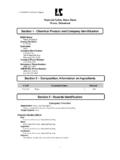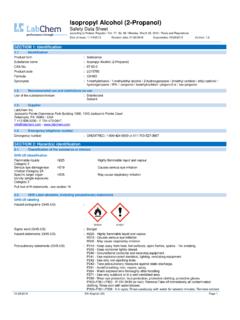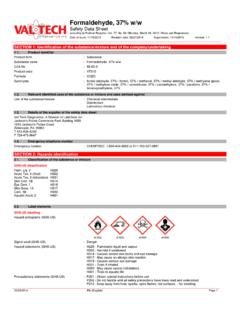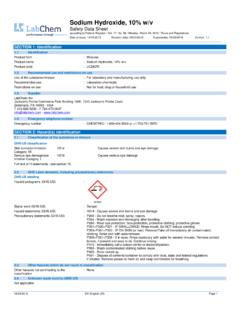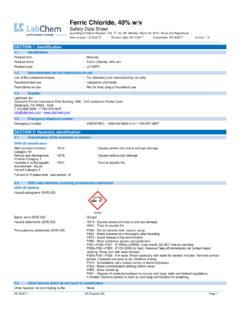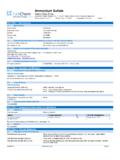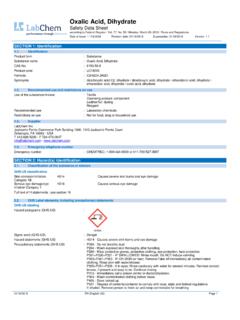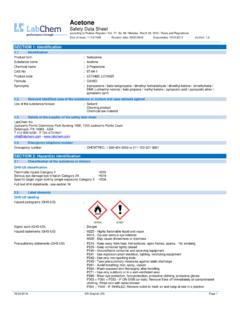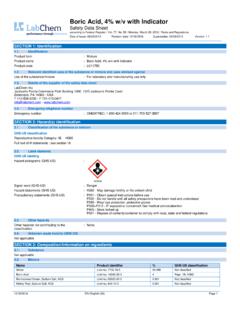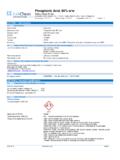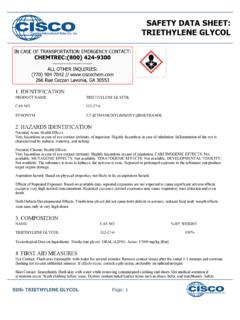Transcription of Potassium Permanganate
1 Potassium Permanganate safety data sheet according to Federal Register / Vol. 77, No. 58 / Monday, March 26, 2012 / Rules and Regulations Date of issue: 02/04/2014 Revision date: 02/13/2018 Supersedes: 02/13/2018 Version: 02/13/2018 EN (English US) Page 1 SECTION 1: Identification Identification Product form : Substance Substance name : Potassium Permanganate CAS-No. : 7722-64-7 Product code : LC19850 Formula : KMnO4 Synonyms : Permanganate of potash / Potassium salt permanganic acid Recommended use and restrictions on use Use of the substance/mixture : Oxidant Bleaching agent Reagent Disinfectant Deodorizer Algicide Dyestuff/pigment: component Medicine Laboratory chemical Food industry: additive Insecticide Germicide Recommended use : Laboratory chemicals Restrictions on use : Not for food, drug or household use Supplier LabChem Inc Jackson's Pointe Commerce Park Building 1000, 1010 Jackson's Pointe Court Zelienople, PA 16063 - USA T 412-826-5230 - F 724-473-0647 - Emergency telephone number Emergency number : CHEMTREC: 1-800-424-9300 or 011-703-527-3887 SECTION 2.
2 Hazard(s) identification Classification of the substance or mixture GHS-US classification Oxidizing solids Category 2 H272 May intensify fire; oxidizer Acute toxicity (oral) Category 4 H302 Harmful if swallowed Hazardous to the aquatic environment - Acute Hazard Category 1 H400 Very toxic to aquatic life Hazardous to the aquatic environment - Chronic Hazard Category 1 H410 Very toxic to aquatic life with long lasting effects Full text of H statements : see section 16 GHS Label elements, including precautionary statements GHS-US labeling Hazard pictograms (GHS-US) : GHS03 GHS07 GHS09 Signal word (GHS-US) : Danger Hazard statements (GHS-US) : H272 - May intensify fire; oxidizer H302 - Harmful if swallowed Potassium Permanganate safety data sheet according to Federal Register / Vol.
3 77, No. 58 / Monday, March 26, 2012 / Rules and Regulations 02/13/2018 EN (English US) 2/9 H410 - Very toxic to aquatic life with long lasting effects Precautionary statements (GHS-US) : P210 - Keep away from heat, sparks, open flames, hot surfaces. - No smoking. P220 - Keep/Store away from clothing, combustible materials P221 - Take any precaution to avoid mixing with combustibles P264 - Wash exposed skin thoroughly after handling. P270 - Do not eat, drink or smoke when using this product. P273 - Avoid release to the environment. P280 - Wear protective gloves, protective clothing, eye protection, face protection. P301+P312 - IF SWALLOWED: Call a POISON CENTER or doctor/physician if you feel unwell. P330 - If swallowed, rinse mouth P391 - Collect spillage.
4 P501 - Dispose of contents/container to comply with local, state and federal regulations Other hazards which do not result in classification Other hazards not contributing to the classification : None under normal conditions. Unknown acute toxicity (GHS US) Not applicable SECTION 3: Composition/Information on ingredients Substances Substance type : Mono-constituent Name Product identifier % GHS-US classification Potassium Permanganate (Main constituent) (CAS-No.) 7722-64-7 100 Ox. Sol. 2, H272 Acute Tox. 4 (Oral), H302 Aquatic Acute 1, H400 Aquatic Chronic 1, H410 Full text of hazard classes and H-statements : see section 16 Mixtures Not applicable SECTION 4: First-aid measures Description of first aid measures First-aid measures general : Check the vital functions.
5 Unconscious: maintain adequate airway and respiration. Respiratory arrest: artificial respiration or oxygen. Cardiac arrest: perform resuscitation. Victim conscious with labored breathing: half-seated. Victim in shock: on his back with legs slightly raised. Vomiting: prevent asphyxia/aspiration pneumonia. Prevent cooling by covering the victim (no warming up). Keep watching the victim. Give psychological aid. Keep the victim calm, avoid physical strain. Depending on the victim's condition: doctor/hospital. First-aid measures after inhalation : Remove the victim into fresh air. Respiratory problems: consult a doctor/medical service. First-aid measures after skin contact : Wash immediately with lots of water (15 minutes)/shower. Do not apply (chemical) neutralizing agents.
6 Remove clothing while washing. Do not remove clothing if it sticks to the skin. Cover wounds with sterile bandage. Consult a doctor/medical service. If burned surface > 10%: take victim to hospital. First-aid measures after eye contact : Rinse immediately with plenty of water for 15 minutes. Do not apply neutralizing agents. Take victim to an ophthalmologist. First-aid measures after ingestion : Rinse mouth with water. Immediately after ingestion: give lots of water to drink. Do not induce vomiting. Immediately consult a doctor/medical service. Call Poison Information Centre ( ). Take the container/vomit to the doctor/hospital. Ingestion of large quantities: immediately to hospital. Most important symptoms and effects (acute and delayed) Symptoms/effects after inhalation : AFTER INHALATION OF DUST: Dry/sore throat.
7 Coughing. Irritation of the respiratory tract. Irritation of the nasal mucous membranes. EXPOSURE TO high CONCENTRATIONS: Respiratory difficulties. FOLLOWING SYMPTOMS MAY APPEAR LATER: Risk of lung edema. Symptoms/effects after skin contact : Tingling/irritation of the skin. May stain the skin. ON CONTINUOUS EXPOSURE/CONTACT: Caustic burns/corrosion of the skin. Symptoms/effects after eye contact : Corrosion of the eye tissue. Inflammation/damage of the eye tissue. ON CONTINUOUS EXPOSURE/CONTACT: Permanent eye damage. Symptoms/effects after ingestion : Nausea. Vomiting. Diarrhoea. Irritation of the gastric/intestinal mucosa. AFTER ABSORPTION OF LARGE QUANTITIES: Possible esophageal perforation. Shock. Slowing heart action. Low arterial pressure. Possible laryngeal spasm/oedema.
8 Respiratory difficulties. Potassium Permanganate safety data sheet according to Federal Register / Vol. 77, No. 58 / Monday, March 26, 2012 / Rules and Regulations 02/13/2018 EN (English US) 3/9 Chronic symptoms : ON CONTINUOUS/REPEATED EXPOSURE/CONTACT: Respiratory difficulties. Impairment of the nervous system. Movement disturbances. Coordination disorders. Myasthenia. Tremor. Paralysis. Cramps/uncontrolled muscular contractions. Impaired memory. Emotional instability. Immediate medical attention and special treatment, if necessary No additional information available SECTION 5: Fire-fighting measures Suitable (and unsuitable) extinguishing media Suitable extinguishing media : Adapt extinguishing media to the environment. Preferably: quantities of water.
9 Unsuitable extinguishing media : No unsuitable extinguishing media known. Specific hazards arising from the chemical Fire hazard : DIRECT FIRE HAZARD. Non combustible. INDIRECT FIRE HAZARD. Promotes combustion. Reactions involving a fire hazard: see "Reactivity Hazard". Explosion hazard : INDIRECT EXPLOSION HAZARD. Reactions with explosion hazards: see "Reactivity Hazard". Reactivity : Decomposes on exposure to temperature rise: oxidation which increases fire hazard. Reacts with combustible materials: risk of spontaneous ignition. Violent to explosive reaction with (some) acids: release of toxic and corrosive gases/vapours. Reacts violently with many compounds : with organic material and with (strong) reducers. With (some) metals. With (increased) risk of fire/explosion.
10 Special protective equipment and precautions for fire-fighters Precautionary measures fire : Exposure to fire/heat: keep upwind. Exposure to fire/heat: consider evacuation. Firefighting instructions : Cool tanks/drums with water spray/remove them into safety . Do not move the load if exposed to heat. Take account of environmentally hazardous firefighting water. Use water moderately and if possible collect or contain it. Protection during firefighting : Heat/fire exposure: compressed air/oxygen apparatus. SECTION 6: Accidental release measures Personal precautions, protective equipment and emergency procedures For non-emergency personnel Protective equipment : Gloves. Face-shield. Protective clothing. Dust cloud production: compressed air/oxygen apparatus.
